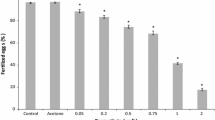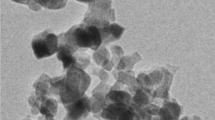Abstract
Irgarol and Diuron are the most representative “organic booster biocides” that replaced organotin compounds in antifouling paints. It cannot be assumed beforehand that their use will have no environmental impact: more ecotoxicological data and a significant environmental monitoring are required. Spermio and embryotoxicities of the biocides Irgarol and Diuron were investigated on Paracentrotus lividus, the dominant echinoid species of the Mediterranean Sea. Spermiotoxicity was studied by assessing the effects of sperm exposure on fertilization rate as well as on the induction of transmissible damages to the offspring. Embryotoxicity was studied by assessing the developmental defects in the exposed larvae. The experimental results show a Diuron EC50 of 2.39 (± 0.21) mg/L with a NOEL of 0.25 mg/L for embryos, and of 5.09 (± 0.45) mg/L with a NOEL of 0.5 mg/L for sperms, respectively. Data obtained from the embryotoxicity test on Irgarol [EC50 0.99 (± 0.69) mg/L] are of the same order of magnitude as the literature data about Japanese urchins. Spermiotoxicity tests show an Irgarol EC50 of 9.04 (± 0.45) mg/L with a NOEL of 0.1 mg/L. These data show the different sensitivities of the two tests: embryos are more sensitive than sperms for both the tested chemicals and Diuron seems to be the less toxic one. Moreover, as a major output of the experimental work, tested herbicides exert transmissible damage to spermatozoa evidenced by larval malformations in the offspring, mainly P1 type (skeletal alterations). The comparison of the endpoints results offers an interesting indication of a probable different mode of action (Irgarol seems to interact with calcium homeostasis) of the two biocides.




Similar content being viewed by others
References
Alzieu C, Heral Y, Thibaud J, Dardignac MJ, Feuillet M (1982) Influence of organostannic-based antifouling paints on the cockle calcification of the oyster Crassostrea gigas. Rev Trav Inst Peches Marit 4:101–116
Andreae MO, Byrd JT, Froelich PN (1983) Arsenic, antimony, germanium, and tin in the Tejo Estuary, Portal; modeling a polluted estuary. Environ Sci Technol 17:731–737
Bay S, Burgess R, Nacci D (1993) Status and applications of echinoid (Phylum Echinodermata) toxicity test methods. In: Landis WG, Hughes JS, Lewis MA (eds) Environmental toxicology risk assessment. ASTM STP 1179, pp 281–302. American Society for Testing and Materials. Philadelphia, PA, USA
Bougis P, Corre MC, Etienne M (1979) Sea urchin as a tool for assessment of the quality of seawater, Ann Inst Oceanog Paris 55:21–26
Brady RF Jr (2000) No moretin: What now for fouling control? J Protect Coat Linings (June) 42:79–83
Cesar A, Marìn sA, Marìn-Guirao L, Vita R (2004) Amphipod and sea urchin tests to assess the toxicity of Mediterranean sediments: the case of Portmàn Bay, Sci Mar 68(Suppl 1):205–213
Chapman PM, Long ER (1983) The use of bioassays as part of a comprehensive approach to marine pollution assessment. Mar Pollut Bull 14:81–84
Chiavarini S, Cremisini C, Morabito R (1996) Organotin compounds in marine organisms In: Element speciation in Biorganic Chemistry. Chemical Analysis series, Vol. 135 John Wiley & Sons Inc. (ed), New York, pp 287–329
Dahl B, Blanck H (1996) Toxic effects of the antifouling agent Irgarol 1051 on periphyton communities in coastal water microcosms. Marine Pollut Bull 32:342–350
ASTM (American Society for Testing and Materials) (2004) Standard guide for conducting static acute toxicity tests with echinoid embryos. ASTM Standard Guide E 1563–98. In: Annual Book of ASTM Standards, Section 11, Vol. 115: Biological effects and environmental fate; biotechnology; pesticides. ASTM, West Conshohochen, PA, USA
Evans SM (1999) TBT or not TBT? That is the question. Biofouling 14 (2):117–129
Fernandez-Alba AR, Hernando MD, Piedra L, Chisti Y (2002) Toxicity evaluation of single and mixed antifouling biocides measured with acute toxicity bioassay. Anal China Acta 456:303–312
Hall Jr LW, Bushong SJ (1996) In: Champ MA, Seligman PF (eds) Organotins: environmental fate and effects. Chapman and Hall, London, pp 157–190
Hernando MD, Ejerhoon M, Fernandez-Alba AR, Chisti Y (2003) Combined toxicity effects of MTBE and pesticides measured with Vibrio fisheri and Daphnia magna bioassays. Wat Res 37:4091–4098
His E, Heyvang I, Geffard O, De Mountadouin X (1999) A comparison between oyster (Crassostrea gigas) and sea urchin (Paracentrotus lividus) larval bioassay for toxicological studies. Wat Res 7:1706–1718
Jones RJ, Muller J, Haynes D, Schreiber U (2003) Effects of herbicides diuron and atrazine on corals of the Great Barrier Reef. MEPS, Australia, 251:153–167
Kobayashi N (1991) Marine pollution bioassay by using sea urchin eggs in the Tanabe Bay, Wakayama Prefecture, Japan, 1970–1987. Marine Pollut Bull 23:709–713
Kobayashi N, Okamura H (2002) Effects of new antifouling compounds on the development of sea urchin. Marine Pollut Bull 44:748–751
Kostantinou IK, Albanis TA (2004) Worldwide occurrence and effects of antifouling paint booster biocides in the aquatic environment: a review. Environ Int 30:253–248
Lamoree M, van der Horst A, Swart CP, van Hattum B (2002) Determination of diuron and the antifouling paint biocide Irgarol 1051 in Dutch marinas and coastal waters. J Chromatogr A 970:183–190
Laughlin RB Jr, Thain J, Davidson B, Valkirs AO, Newton FC (1996) In Champ MA, Seligman PF (eds) Organotins: environmental fate and effects. Chapman and Hall, London, p 192-217
Maccinis-Ng CMO, Ralph PJ (2003) Short term response and recovery of Zostera capricorni photosyntesis after hebicide exposure. Aquat Bot 76(1):1–15
Maguire RJ (1987) Environmental aspect of tributyltin. Appl Organomet Chem 1:475–498
Manzo S (2004) Sea urchin embryotoxicity test: proposal for a simplified bioassay. Ecotox Environ Safety 57(2):123–128
Manzo S, Torricelli L (2000) Preliminary findings about Regione Campania (South Italy) coastal water ecotoxicological data. Abstract book of II, National Conference of Sea Science, Geneva, 21/25 November, p 223
Marin MG, Moschino V, Cima F, Celli C (2000) Embryotoxicity of butyltin compounds to the sea urchin Paracentrotus lividus. Mar Environ Res 50:231–235
Okamura H, Aoyama I, Liu D, Maguire J, Pacepavicius CG, Lau YL (2000) Fate and ecotoxicity of the new antifouling compound Irgarol 1051 in the aquatic environment. Wat Res 34(14):3523–3530
Omae I (2003) Organotin antifouling paints and their alternatives. Appl Organometal Chem 17:81–105
Pagano G, Cipollaro M, Corsale G, Esposito A, Ragucci E, Giordano GG, Trieff NM (1986) The sea urchin: Bioassay for the assessment of damage from environmental contaminants. In: Cairns Jr (ed) Community Toxicity Testing. ASTM STP920, pp, 66–92, American Society for Testing and Materials. Philadelphia, PA, USA
Pagano G, Corsale G, Esposito A, Dinnel PA, Romana LA (1989) Use of sea urchin sperm and embryo bioassay in testing the sublethal toxicity of realistic pollutant level. Adv Appl Biotech Ser 5:153–163
Pagano G, Iaccarino M, Guida M, Manzo S, Oral R, Romanelli R, Rossi M (1996a) Cadmium Toxicity in Spiked Sediment to sea urchin embryos and sperm. Mar Environ Res 42(1–4): 54–55
Pagano G, His E, Beiras R, De Biase A, Korkina LG, Iaccarino M, Oral R, Qiuniou, Warnau M, Trieff NM (1996b) Cytogenetic, developmental, and biochemical effects of aluminium, iron, and their mixture in sea urchins and mussels. Arch Environ Contam Toxicol 31:466–474
Ringwood Huffman A (1992) Comparative sensitivity of gametes and early developmental stages of a sea urchin species (Echinometra mathei) and a bivalve species (Isognomon californicum) during metal exposures. Arch Environ Contain Toxicol 22:288–265
Scarlett A, Donkin ME, Fileman TW, Donkin P (1997) Occurrence of the marine antifouling agent Irgarol 1051 within Plymouth Sound locality: implications for the green macroalga Enteromorpha intestinalis. Marine Pollut Bull 34(8):645–651
Thomas KV, Fileman TW, Readman J, Waldock MJ (2001) Antifouling paint booster biocides in the U.K. coastal environment and potential risks of biological effects. Mar Pollut Bull 42:677–688
Thomas KV, McHugh M, Waldock M (2002) Antifouling paint booster biocides in UK coastal waters: inputs, occurrence and environmental fate. Sci Total Environ 293:117–127
Thompson JAJ, Sheffer MG, Pierce RC, Chau YK, Cooney JJ, Cullen WR, Maguire RJ (1985) Organotin compounds in the aquatic environment: Scientific criteria for assessing their effects on environmental quality. Nat Res Counc Can Ottawa Publ NRCC 22494, p 284
US EPA (1993) A linear interpolation method for sublethal toxicity: the inhibition concentration (ICp) approach. National Effluent Toxicity Assessment Center Technical Report 03-93, Environmental Research Laboratory, Duluth, Minnesota
US EPA (1995) Short-term methods for estimating the chronic toxicity of effluents and receiving waters to weast coast marine and estuarine organisms. EPA/600R95136. Cincinnati, OH, USA
US EPA Office of Pesticide Programs (2000) Pesticide ecotoxicity database (Formerly: Environmental Effects Database [EEDB]). Environmental Fate and Effects Division, Washington, DC
Van Wezel AP, Vlaardingen P (2004) Environmental risk limits for antifouling substances. Aquat Toxicol 66:427–444
Voulvoulis N, Scrimshaw MD, Lester JN (1999) Alternative antifouling biocides. Appl Organomet Chem 13:135
Waldock MJ, Thain JE (1983) Shell thickness in Crassostrea gigas: Organotin antifouling of sediment induced. Marine Pollut Bull 14:411–415
Author information
Authors and Affiliations
Corresponding author
Rights and permissions
About this article
Cite this article
Manzo, S., Buono, S. & Cremisini, C. Toxic Effects of Irgarol and Diuron on Sea Urchin Paracentrotus lividus Early Development, Fertilization, and Offspring Quality. Arch Environ Contam Toxicol 51, 61–68 (2006). https://doi.org/10.1007/s00244-004-0167-0
Received:
Accepted:
Published:
Issue Date:
DOI: https://doi.org/10.1007/s00244-004-0167-0




